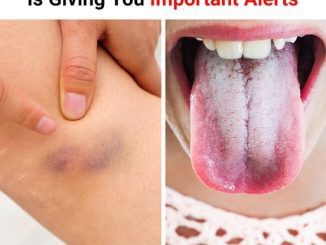Strokes are often associated with older adults, but the reality is that young people, even teenagers, can suffer from them too. Recently, a shocking case of a 19-year-old experiencing a stroke after a severe headache has raised serious concerns. Recognizing the early warning signs can make the difference between life and long-term disability—or even death.
1. Sudden, Severe Headache – A Major Red Flag

A headache might seem harmless, but if it strikes suddenly and feels more intense than anything you’ve ever experienced, it could signal a stroke.
What Happens?
- A sudden, unbearable headache that appears without warning.
- Pain that worsens rapidly and doesn’t respond to usual pain relief.
- Possible nausea, vomiting, or confusion alongside the headache.
What It Means
A stroke-related headache can be caused by bleeding in the brain (hemorrhagic stroke) or a blocked artery (ischemic stroke). If a headache feels “different” from the usual, especially if it comes with other symptoms, don’t ignore it—seek medical help immediately.
2. Weakness or Numbness – Especially on One Side of the Body
Numbness or weakness, particularly when it affects only one side of the body, is a serious warning sign.
What Happens?
- You may feel sudden weakness in your arm, leg, or face.
- A tingling sensation or complete numbness may occur.
- You might find it hard to lift objects or even walk properly.
What It Means
A lack of blood flow to the brain can cause nerve function loss, leading to weakness or paralysis. If one side of your body feels “off,” you could be experiencing the early stages of a stroke.
3. Difficulty Speaking or Understanding – A Brain Signal Gone Wrong
If a person suddenly struggles to talk, slurs their words, or doesn’t seem to understand what’s being said, it could be a stroke symptom.
What Happens?
- Words may come out slurred or jumbled.
- It might be difficult to form a sentence or comprehend conversations.
- The person may appear confused, unable to respond properly.
What It Means
The brain’s language center is highly vulnerable during a stroke. If speech is impaired suddenly and without explanation, immediate medical attention is crucial.
4. Vision Problems – A Distorted or Blurry World

Your eyesight could be one of the first indicators of a stroke, even before other symptoms appear.
What Happens?
- Sudden blurred or double vision.
- Partial or total loss of vision in one or both eyes.
- Trouble focusing or seeing clearly, even if only for a few seconds.
What It Means
A stroke can affect the brain’s vision center, leading to sudden vision problems. If you experience unexplained visual disturbances, don’t brush them off—it could be your brain crying for help.
5. Loss of Balance or Coordination – When Walking Becomes a Challenge
Feeling dizzy or uncoordinated isn’t always just fatigue—it could mean a stroke is happening.
What Happens?
- Sudden dizziness or vertigo.
- Unstable walking, stumbling, or falling for no reason.
- Trouble coordinating movements or performing basic tasks.
What It Means
The cerebellum, which controls balance and movement, can be affected by a stroke. If you find yourself struggling to walk straight or feeling “off balance” without reason, don’t ignore it.
What to Do in an Emergency – Act F.A.S.T.

If you or someone else experiences these symptoms, time is of the essence. Use the F.A.S.T. method to identify and react to a stroke quickly:
- Face: Is one side of the face drooping?
- Arms: Can both arms be raised evenly, or is one weak?
- Speech: Is speech slurred or difficult?
- Time: If any of these signs appear, call emergency services immediately.
Seconds count in stroke treatment—delays can lead to irreversible brain damage.
How to Lower Stroke Risk in Young People
Although strokes in young adults are less common, they are becoming more frequent due to modern lifestyle factors. Here’s how to reduce your risk:
1. Maintain a Balanced Diet
- Eat more fruits, vegetables, and whole grains.
- Avoid processed, high-sodium, and high-fat foods.
- Stay hydrated and limit sugar intake.
2. Stay Active and Maintain a Healthy Weight
- Exercise at least 30 minutes a day, five times a week.
- Engage in physical activities like walking, cycling, or swimming.
- Keep your weight in check to avoid obesity-related stroke risks.
3. Quit Smoking and Limit Alcohol
- Smoking doubles the risk of stroke—quit as soon as possible.
- Excessive alcohol can increase blood pressure, a major stroke risk.
- Opt for healthier lifestyle choices to protect your heart and brain.
4. Monitor Blood Pressure and Cholesterol
- High blood pressure is a silent killer—get regular check-ups.
- Keep cholesterol levels in check by eating heart-friendly foods.
- If needed, follow medical advice for controlling these risk factors.
Conclusion – Don’t Ignore the Signs
Strokes can happen to anyone, even young people in their teens and twenties. The case of a 19-year-old suffering a stroke after a headache is a stark reminder that early detection is key. Recognizing the 5 dangerous warning signs—severe headache, weakness, speech trouble, vision problems, and loss of coordination—can save a life.
If you or someone you know experiences these symptoms, act immediately. Stroke treatment is most effective when given quickly, so don’t wait—call emergency services right away. Your future health depends on the actions you take today.


